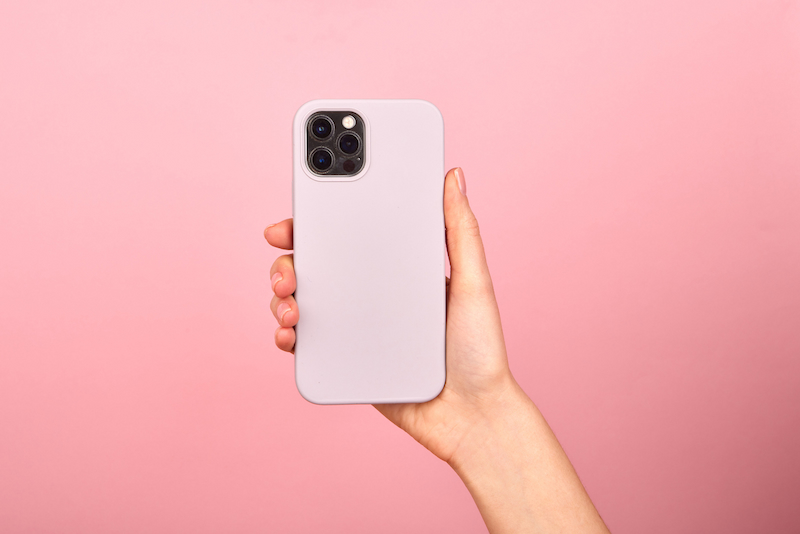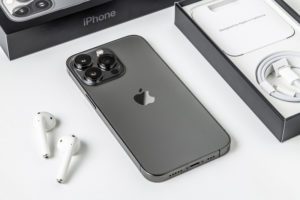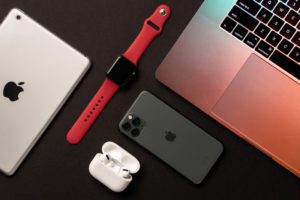The Growth of the iPhone Over the Years

Before 2007, Apple concentrated on producing top-of-the-range computers and portable music players. These devices were the first popular tech which used a digital MP3 format, instead of the common clunky portable CD players and quickly diminishing Walkman (cassette players for our younger readers, if you’re still unsure what one is, ask your parents to dig out their old tech).
We explore Apple’s dive into the world of mobile phones and the history of the iPhone over the past 15 years.
The first iPhone
After its continuous support of technology, in 2007, Apple introduced its first phone—the iPhone. This flagship moment for Apple opened up a new world of possibilities and competition with other tech companies like Siemens, Motorola, and Samsung. Surprisingly, the design of the iPhone has not changed over the years. The shape, interface and functions remain relatively the same. The only things that have changed are the buttons, size, and casing. The first iPhone display consisted of a single button with an entire glass screen with an LCD screen, unlike the AMOLED screens in phones today.
The screen of the original iPhone was a modest 3.5” and had an unbelievable 128MB of storage, which, if you were to compare it to the current iPhone 14, which has 128GB, seems nothing. However, back in 2007, the need for more storage was unnecessary. There was nowhere near the number of apps we use today, and the most excitement you could get from the App Store was the memorable fake beer app. It did have a rear camera, but it was only 2 megapixels, which is much less quality than the selfie camera on most phones today. Interestingly, as Apple had no experience before the iPhone in creating hardware for mobile phones, they installed a Samsung 32-bit microprocessor. It weighed much less than most phones, even with the aluminium casing and came in at 4.8 ounces, 1.7 ounces less than the iPhone X. Upon the first release, they cost around £400 and quickly became a sought-after phone.
The next step for Apple
Besides the step to 3G, with the iPhone 3G and 3GS, the next significant move was introducing a thinner display frame to maximise the screen. This was introduced in 2010 with the iPhone 4. Other features included introducing the front-facing camera, which opened up the ability to video call face-to-face with other iPhone users through FaceTime. Before the world of meta, WhatsApp and other video-calling services, other service providers had attempted to introduce face-to-face video calling, but nothing quite gained popularity until the introduction of FaceTime.

In addition to FaceTime, this phone came with updates to organise your apps into folders. With so many more platforms utilising app versions, such as Facebook and Twitter, being able to store and organise them into folders offered a much easier user experience.
Hey Siri…
Another flagship moment was the introduction of Siri. Siri was first brought out with the iPhone 4S in 2011 and was soon followed by other voice assistants like Cortana, Google Now, and eventually Alexa. The introduction of Apple’s new voice assistant was the first time people could interact with their smartphone audibly and was the start of what would be standard technology in years to come.

Apple realised that users’ smartphones were forming an assistant in their lives. Adding a voice to the phone humanised the device and could lead to a stronger connection between users and the brand. Although the feature initially received mixed reviews, it offered the chance to call contacts hands-free, send text messages without touching the phone and even read emails allowed as you continue working. Since then, the ability of Siri has improved with the function to search the internet for specific answers, find recipes and even play your favourite songs. Siri can also connect to other Apple products, allowing you to control other devices from instructions to your phone.
Hit the road, jack
Whilst Samsung and other big brands have branched out in the design and style of their phones, Apple has stuck with their guns and has kept the method easy and straightforward from day one. Although the cases have evolved into sleeker and thinner designs, the concept of the iPhone remains visually identical from the first day, excluding the home button and headphone jack. From fingerprint Touch ID to photo AirDrop and Apple Pay, many introductions of technology and features have been designed to make life easier and more connected.
These standard features started to disappear with the introduction of the iPhone 7, which was the first model without the headphone jack. Although AirPods were available, the steep price left many iPhone users a little miffed. Whilst you could still connect to any Bluetooth headphones, they were not of the same quality and had a long way to go before being as cheap and popular as wired. The phones did compromise with an adapter for the charging port, but it was small and easy to misplace. The Home button vanished with the iPhone X but was not as sorely missed as the jack and actually offered a much sleeker design, with less chance of breaks.
What’s next for Apple?
Apple only ever used to bring out one phone a year; whether it was the next series up or the expansion for the current device, there was only one launch a year. In comparison, the iPhone 14 was released in September 2022, with the upgraded and more advanced versions, the iPhone 14 Pro Max and the iPhone Pro also being launched the same day.

If the past is anything to go by, Apple will continue following the same design and style of the phone from day one, with adjustments and improvements. There are rumours of them expanding with other technologies, such as AR glasses, but will these be compatible with the iPhone? Replacing a phone with a simple pair of glasses. Who knows? What we do know is that if you are looking for continuity, then an iPhone is the device for you!
The iPhone timeline
- 2007 – Apple introduces the iPhone.
- 2008 – The iPhone advances with 3G connectivity with iPhone 3G.
- 2009 – The iPhone 3GS was launched with improved speed (hence the “S”).
- 2010 – iPhone 4 had the first front camera allowing for FaceTime and selfies.
- 2011 – Siri was born with the launch of the iPhone 4S.
- 2012 – The iPhone 5 allowed easier photo sharing, and the iPhone’s screen was expanded in length for the first time.
- 2013 – The iPhone 5S and iPhone 5C saw an increase in Apple converters with bright colours offered in the 5C and improved speeds with the 5S and fingerprint scanning.
- 2014 – The iPhone 6 and iPhone 6 Plus introduced Apple Pay to users.
- 2015 – We saw the iPhone 6S and iPhone 6S Plus seamlessly connecting to cars with CarPlay.
- 2016 – Apple listened to its customers and their issues with the increased screen sizes of the iPhone 6 series and released the iPhone SE (Special Edition). This iPhone 5-sized device offered the newer phone technology in a unique compact edition. In addition, they released the iPhone 7 and the iPhone 7 Plus, which were much larger.
- 2017 – Unlike previous years, this year saw the introduction of the iPhone 8, iPhone 8 Plus and the iPhone X. This was when the names of iPhones began to deter from their original style. And, of course, we saw the loss of the Home button, offering a larger screen size.
- 2018 – Expanding on their 10th anniversary iPhone X, we saw Memojis, group FaceTime and Screen Time (yeah, we don’t like checking that either) with the iPhone XS, the iPhone XS Max and the iPhone XR.
- 2019 – This was the first year we saw Apple introduce the full spectrum of series with the iPhone 11, iPhone 11 Pro and iPhone 11 Pro Max.
- 2020 – Despite the pandemic, Apple was still able to release the iPhone 12, which offered an upgrade from the iPhone 11 with a Super Retina XDR OLED. The iPhone 12 Mini, the iPhone 12 Pro and the iPhone 12 Pro Max also came out at a virtual launch.
- 2021- Apple introduced the iPhone 13, alongside its counterparts, the iPhone 13 Pro and the iPhone 13 Pro Max. We also saw the continuation of the small hands-friendly iPhone 13 Mini.
- 2022- This year introduced the iPhone 14, the iPhone 14 Pro and the iPhone 14 Pro Max, with even faster speeds, various screen sizes and their most impressive phone to date.
If you are looking to trade in your iPhone for an upgrade or sell another Apple device why not choose Mazuma? We offer incredible prices and the best service; we can offer a quote in minutes!

